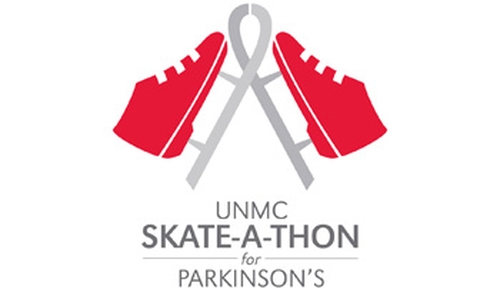Previous three Skate-a-thons have raised total of $110,000
The show must go on.
Even though Colleen Wuebben, the driving force behind the UNMC Skate-a-thon for Parkinson’s, passed away 10 months ago, the fourth annual event will continue on Jan. 10-11 at the UNMC Ice Rink.
“There was never a doubt,” said Ted Wuebben, Colleen’s husband. “Colleen loved the Skate-a-thon. She knew how meaningful it is to families fighting Parkinson’s disease and how it gives them hope. She made it very clear that she wanted it to continue after she was gone.”
Colleen died on Feb. 13. She was 60.
The 24-hour event will run from noon on Jan. 10 to noon on Jan. 11. To accommodate people who will just be getting off work, an opening ceremony will take place at 4:30 p.m. on Jan. 10. Closing ceremonies will be held at 11:30 a.m. on Jan. 11.
This year’s Skate-a-thon will feature a couple new wrinkles:
- Four skaters, including a retired dentist, who are planning to skate the entire 24 hours;
- In an effort to increase fundraising, teams of skaters will be registered this year with several of the teams having at least one team member on the ice throughout the event. A prize will be awarded to the team raising the most money.
The previous three skate-a-thons at UNMC netted more than $110,000.
Proceeds go toward:
- Clinical and basic science Parkinson’s research at UNMC; and
- The PHD Program (Parkinson’s Health Development), a non-profit, local program that offers affordable exercises and activities to improve the quality of life for persons with Parkinson’s.
The public is invited to attend and participate. Cost is $10 for individuals. The registration fee includes skate rental and ice access. People can skate as long as they wish.
The UNMC Ice Rink, which is located east of 42nd Street about halfway between Dewey Avenue and Emile Street, can handle up to 125 people on the ice at any time. It is located north of the Sorrell Center and south of the UNMC College of Pharmacy.
A heated tent will allow skaters and spectators a place to stay warm. There also will be hot drinks, food and snacks. DJs and guest emcees will keep the event moving, as skaters will groove to continual music.
Other highlights of the 2014 Skate-a-thon include a “Pajama Skate,” a “Halfway There Skate” and a “Shiver Skate” in light clothing in the spirit of a polar plunge.
The Wuebbens came up with the idea for the Skate-a-thon in 2008. Prior to moving the event to UNMC in 2011, they flooded their back yard and held the event at their home for the first three years. Colleen was diagnosed with Parkinson’s in 2005 at the age of 52.
Skaters and non-skaters can register online or make a pledge at http://www.unmc.edu/publicrelations/skateathon.htm. Walk-in registration also will be available at the event.
Sponsorships are still available. For information on becoming a sponsor, go to http://www.unmc.edu/publicrelations/skateathon_become-a-sponsor.htm.
Tentative Schedule of Events
Friday – Jan. 10
Noon Kickoff – Skating begins
3:30-4 p.m. After school snack to be given to all skaters
4:30 p.m. Opening ceremonies
6 p.m. DJ Jake Ryan will serve as emcee
8 p.m. Dance Party on the ice
10:30 p.m. “Thrift Shop” giveaway
11 p.m. Pajama Skate
Saturday – Jan. 11
Midnight Halfway there photo and midnight munchies
1 a.m. Shiver Skate
6 a.m. Sunrise Skate
11:30 a.m. Closing ceremonies
Location
The skate-a-thon will take place on UNMC’s Ice Rink, which is located east of 42nd Street about halfway between Dewey Avenue and Emile Street. It is located north of the Sorrell Center and south of the UNMC College of Pharmacy.
View parking map
View Google map
Facts about Parkinson’s disease:
- Is a motor system disorder resulting from the loss of dopamine-producing brain cells.
-
The four primary symptoms of Parkinson’s are:
– tremor or trembling in hands, arms, legs, jaw and face;
– rigidity or stiffness of the limbs and trunk;
– slowness of movement; and
– postural instability or impaired balance and coordination. - As many as one million Americans currently live with Parkinson’s. This is more than the combined number of people with multiple sclerosis, muscular dystrophy and Lou Gehrig’s disease.
- Approximately 60,000 more are diagnosed each year, and this number doesn’t reflect the thousands of cases that go undetected.
- An estimated seven to 10 million people worldwide are living with Parkinson’s disease.
- Affects about 3 percent of the population over the age of 65.
- Men are 1.5 times more likely to have Parkinson’s than women.
- Incidence will double in the next 40 years with the number of elderly people soaring.
- Incidence of Parkinson’s increases with age, but an estimated 4 percent of people with Parkinson’s are diagnosed before the age of 50.
- There is no cure for Parkinson’s, but a variety of medications provide relief from the symptoms.
